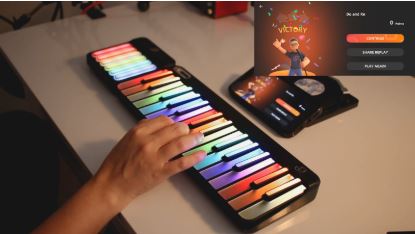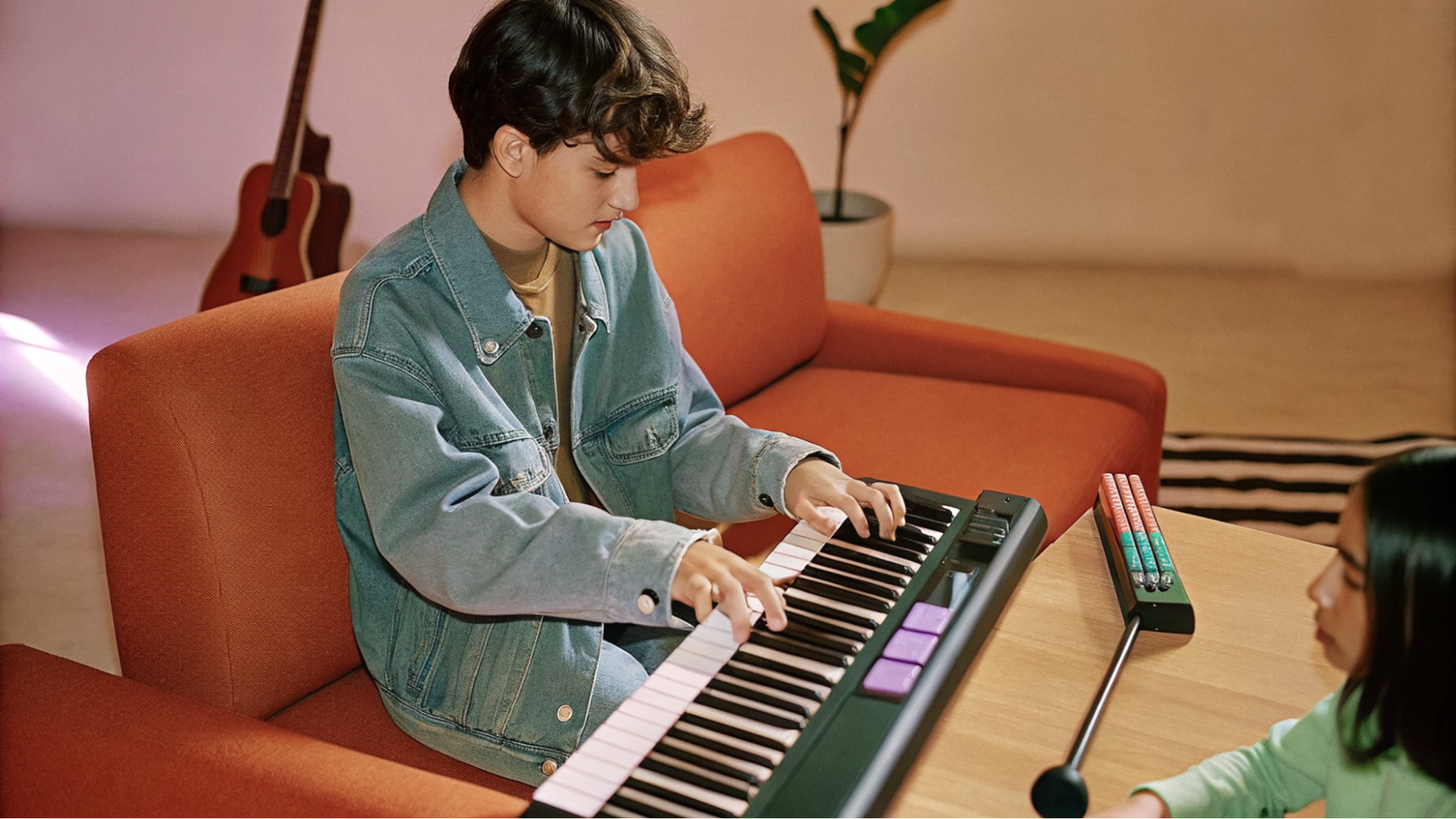If you want an instrument you’ll actually play every day, a smart portable piano is hard to beat. It’s small enough for a desk, quiet enough for apartments, and thanks to guided lights and lesson apps beginner‑friendly from the first session. This guide explains what to look for, how smart models compare to traditional keyboards, and why a modular, light‑guided pick is our top recommendation for most beginners.
What counts as a “smart portable piano”?
A smart portable piano is a compact digital instrument (often 29–61 keys) that pairs with a learning app and includes interactive guidance typically LED keys, course content, progress tracking, and Bluetooth/USB‑MIDI. Compared with a regular practice keyboard, a smart model:
-
shows where to place your fingers with follow‑lights
-
pauses and waits if you miss a note (no stress)
- loops tricky bars and slows songs by percentage
-
supports headphone practice for quiet sessions
- connects to music apps/DAWs for creation
In other words: it’s the best keyboard piano format if your priorities are quick wins, portability, and low‑friction practice.
Editor’s Choice — PopuPiano Smart Keyboard

Why it stands out as the best piano keyboard for new players
-
Follow the Lights: >95% transparency full‑key multi‑color LEDs guide both melody and chords.
-
Expressive feel: 127‑level velocity sensitivity lets you shape soft/loud naturally.
-
Right‑sized keys: 7/8‑width keys are kinder to smaller hands while staying musical.
-
Modular design: start with the 29‑Key Master; add the 24‑Key Expansion when you need more range; snap on the Chord Pad for one‑tap harmony and beat control.
-
Creator‑ready: Bluetooth/USB‑MIDI for GarageBand/Logic/FL Studio; battery‑friendly for couch or travel sessions.
-
Durable & safe: ABS/PC construction is light and easy to clean.
Specs at a glance
-
Master 29‑Key: 13.3 × 4.8 × 1.3 in; 1.43 lb
-
Expansion 24‑Key: 11 × 4.8 × 1.3 in; 1.10 lb
-
Expansion Chord Pad (6×3 sensors): 4.7 × 4.7 × 1.3 in; 0.62 lb
App highlights (learn • play • create)
-
Follow the Lights: pick a song, see lyrics/chords, and play with real‑time guidance.
-
Compose with AI in Three Notes: drop three notes, spark a melody, and edit it.
-
Practice Feels Like Play: gamified lessons and progress goals.
-
Jam with Light and Voice: sing and play simultaneously with visual chord prompts.
-
Modular Music: treat the system like musical LEGO expand when you’re ready.
Who it fits
-
Kids: learn by light, not notation; short, fun sessions keep momentum.
-
Performers: chord pad + keys = sing‑along sets fast.
-
Creators: compact MIDI workstation without giving up playability.
If your search terms are “best keyboards piano” or “best piano keyboards” for a small space, this is the rare option that covers learning, performing, and creating in one portable setup.
Smart portable piano vs other compact options
|
Option
|
Best for
|
Pros
|
Considerations
|
|
Smart portable piano
|
Beginners, apartment practice, creators
|
Follow‑lights, app lessons, MIDI, headphones
|
Usually fewer keys than a full 88; learning features vary by model
|
|
61‑key practice keyboard
|
Budget learners wanting more range
|
Wider span for two hands; built‑in speakers
|
No guided lights on most units; lessons depend on third‑party apps
|
|
MIDI controller (no sounds)
|
Producers making beats/loops
|
Cheapest path to DAWs; pads/knobs
|
No speakers; no built‑in lessons; steeper start for players
|
|
88‑key digital piano
|
Classical technique & full range
|
Weighted action, full piano feel
|
Larger/heavier; higher cost; not as travel‑friendly
|
If you want the best keyboard piano for starting fast at home, a smart portable wins on setup time and motivation. If classical repertoire is your day‑one goal, an 88‑key weighted piano still makes sense later.
How to choose the best piano keyboard (compact buyer’s checklist)

-
Key feel
- Minimum: velocity‑sensitive keys (volume changes with touch).
- Nice to have: graded/weighted action if you plan to move into classical pieces.
-
Key count
- 29–37 keys: ultra‑portable; great for melody, chords, and practice drills.
- 49 keys: sweet spot for most beginners.
- 61 keys: extra room for left‑hand patterns.
-
Learning tools
- LED follow‑lights and wait mode accelerate the first month.
- Loop/slowdown and progress tracking keep you consistent.
-
Connectivity
- Bluetooth/USB‑MIDI for apps/DAWs.
- Headphones for quiet practice.
-
Portability
- Weight under ~3 lb per module is ideal for backpack carry.
- Battery option extends where you can play.
-
Durability & care
- Smooth plastics (ABS/PC) clean easily; snug keys reduce rattles.
-
Growth path
- Modular expansion saves you from “rebuying” when you outgrow the first range.
Deep‑dive: why the modular route pays off
A big reason we rank PopuPiano as a top smart portable piano is the expand‑when‑ready design:
-
Start small for habit building—keep it on the desk and play in five spare minutes.
-
Add 24 keys when two‑hand pieces show up.
-
Clip the Chord Pad for one‑tap harmony while you sing or play lead lines.
-
Flip to MIDI and record parts into your DAW without changing instruments.
This modular path quietly solves the classic beginner problem: buying something huge “for later” and then not practicing because it’s bulky.
Use cases: which configuration should you pick?
-
Apartment practice & late nights
- Core need: headphones, soft touch, minimal footprint.
- Pick: Master 29‑Key + Chord Pad for compact chord‑and‑song sessions.
-
Travel & dorms
- Core need: backpack size, quick setup, battery‑friendly.
- Pick: Master 29‑Key alone; add the Expansion later if you want more range.
-
Songwriting & open‑mics
- Core need: easy accompaniment, lyrics/chords on screen.
- Pick: Master 29‑Key + Chord Pad, then add the 24‑Key Expansion for two‑hand intros/outros.
-
Creators in DAWs
- Core need: MIDI, portability, steady feel.
- Pick: Master 29‑Key for desk work; Expansion for deeper chord voicings; keep the Chord Pad for quick ideas.
Setup in 10 minutes (day‑one quick start)
-
Unbox & power the Master 29‑Key.
-
Install the app on phone/tablet; pair via Bluetooth or plug in USB.
-
Run the short update (adds songs/features).
-
Choose a familiar song; enable Follow the Lights.
-
Play at 60–70% tempo; let the app wait when you miss.
-
Add left‑hand roots on beat 1 by the end of your first session.
-
Save your run—nothing boosts motivation like hearing progress.
30‑day plan (learn • play • create)
Goal: two finished songs + one short original idea.
-
Week 1 — Foundations
- 15–20 min/day.
- Right‑hand melody with lights at slow tempo; left‑hand roots on beat 1.
- Record a 30‑second clip at week’s end.
-
Week 2 — Chords & rhythm
- Add C, F, G, Am, Dm, Em triads; hold for 4 beats; then try half‑note pushes (beats 1 & 3).
- Start Song #2.
-
Week 3 — Two‑hand flow
- Hands together at 70–80% speed.
- Introduce light syncopation (play on 1, “and” of 2, and 4).
-
Try Compose with AI: seed three notes and refine a 4‑bar idea.
-
Week 4 — Polish & share
- Bring both songs near full tempo; add dynamics.
-
Jam with the Chord Pad; sing along once for confidence.
- Export a 60–90 second performance.
This is the best keyboards piano workflow for busy beginners: short, structured, and music‑first.
Pros & possible trade‑offs (honest snapshot)
What you’ll love
- Faster results than a non‑guided keyboard.
- Truly portable; easy to keep within reach.
-
Doubles as a best keyboard piano for practice and as a MIDI controller for creation.
- A modular growth path means you won’t second‑guess your first purchase.
What to know
- Not a cabinet‑style 88‑key with heavy action—if your long‑term plan is Chopin études, you may add a weighted board later.
- As with any smart system, you’ll get the most value by using the app features (lights, loops, slowdown).
Frequently Asked Questions
Is a smart portable piano really better than a regular 61‑key beginner board?
For many learners, yes. Follow‑lights, wait mode, and loop/slowdown shorten the first month dramatically. If you know you need more range immediately, add the 24‑Key Expansion or consider a 61‑key option.
Do I need 88 keys to start?
No. For melody, chords, and pop arrangements, 29–49 keys are plenty at first. Expand later if you want more left‑hand bass or classical repertoire.
Will smaller 7/8‑width keys hurt my technique?
They’re designed for comfort and accessibility. If you move to a full‑size piano later, your rhythm, chords, and reading transfer—hand spacing adapts within a few sessions.
What makes this pick the best piano keyboard for beginners?
A mix of LED guidance, 127‑level touch, MIDI, and modularity—plus a learning app that turns practice into play. That reduces friction so you actually build a daily habit.
Can I create original music on a smart portable piano?
Yes. Use Compose with AI for melody ideas, the Chord Pad for harmony, and MIDI to record into your DAW. It’s a compact sketchpad and a performance tool.
Conclusion
If you’re hunting for the best keyboard piano you’ll use every day, pick the one that removes friction. A smart portable piano with full‑key lights, built‑in lessons, and a modular path gives you quick wins now and room to grow. That’s why our top recommendation is the Smart Keyboard a compact instrument that helps you learn, play, and create on your schedule.




